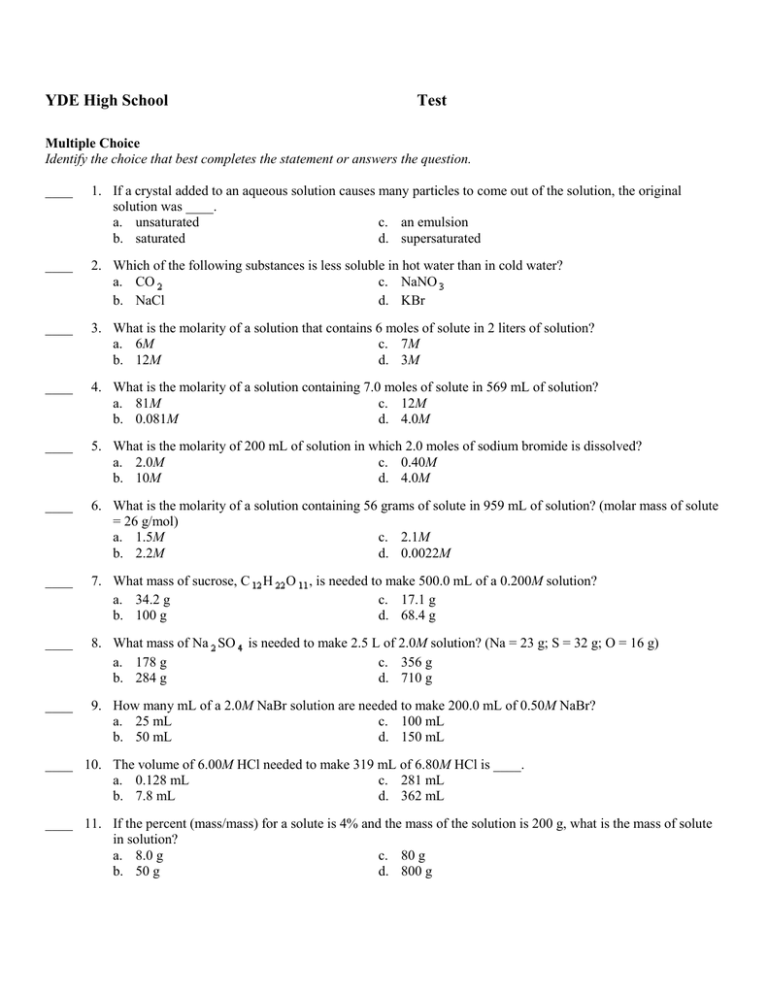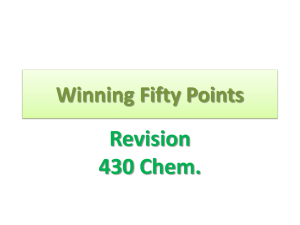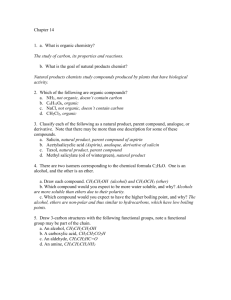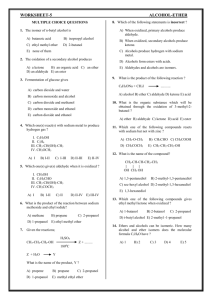YDE Test - St. Raymond High School for Boys
advertisement

YDE High School Test Multiple Choice Identify the choice that best completes the statement or answers the question. ____ 1. If a crystal added to an aqueous solution causes many particles to come out of the solution, the original solution was ____. a. unsaturated c. an emulsion b. saturated d. supersaturated ____ 2. Which of the following substances is less soluble in hot water than in cold water? a. CO c. NaNO b. NaCl d. KBr ____ 3. What is the molarity of a solution that contains 6 moles of solute in 2 liters of solution? a. 6M c. 7M b. 12M d. 3M ____ 4. What is the molarity of a solution containing 7.0 moles of solute in 569 mL of solution? a. 81M c. 12M b. 0.081M d. 4.0M ____ 5. What is the molarity of 200 mL of solution in which 2.0 moles of sodium bromide is dissolved? a. 2.0M c. 0.40M b. 10M d. 4.0M ____ 6. What is the molarity of a solution containing 56 grams of solute in 959 mL of solution? (molar mass of solute = 26 g/mol) a. 1.5M c. 2.1M b. 2.2M d. 0.0022M ____ 7. What mass of sucrose, C H O , is needed to make 500.0 mL of a 0.200M solution? a. 34.2 g c. 17.1 g b. 100 g d. 68.4 g ____ 8. What mass of Na SO is needed to make 2.5 L of 2.0M solution? (Na = 23 g; S = 32 g; O = 16 g) a. 178 g c. 356 g b. 284 g d. 710 g ____ 9. How many mL of a 2.0M NaBr solution are needed to make 200.0 mL of 0.50M NaBr? a. 25 mL c. 100 mL b. 50 mL d. 150 mL ____ 10. The volume of 6.00M HCl needed to make 319 mL of 6.80M HCl is ____. a. 0.128 mL c. 281 mL b. 7.8 mL d. 362 mL ____ 11. If the percent (mass/mass) for a solute is 4% and the mass of the solution is 200 g, what is the mass of solute in solution? a. 8.0 g c. 80 g b. 50 g d. 800 g ____ 12. The volume of alcohol present in 620 mL of a 40.0% (v/v) solution of alcohol is ____. a. 372 mL c. 248 mL b. 40.0 mL d. 580 mL ____ 13. In which of the following is concentration expressed in percent by volume? a. c. 100% 100% b. 100% d. 100% ____ 14. Which of the following is NOT a colligative property of a solution? a. boiling point elevation c. vapor pressure lowering b. supersaturation d. freezing point depression ____ 15. Colligative properties depend upon the ____. a. nature of the solute b. nature of the solvent c. number of solute particles in a solution d. freezing point of a solute ____ 16. What is the name of the functional group in the following compound? a. halogen b. ester c. carbonyl d. carboxylic acid ____ 17. The most important way to classify organic compounds is by ____. a. the number of carbon atoms in the longest chain b. functional group c. the type of carbon—carbon bonds d. reactivity ____ 18. What is the common name of the following compound? a. isopropyl bromide b. tert-butyl bromide c. isobutyl bromide d. sec-butyl bromide ____ 19. Which of the following compounds is trichloromethane? a. c. b. d. ____ 20. Phenols are characterized by ____. a. their behavior as gases b. ether linkages c. an OH group on a benzene ring d. their use as flavoring agents ____ 21. What is the common name of the following alcohol? a. sec-hexyl alcohol b. tert-hexyl alcohol c. isohexyl alcohol d. hexyl alcohol ____ 22. Which of the following compounds is a glycol? a. CH CH CH CH OH c. HOH CCH CH CH OH b. CH CH OCH CH d. CH CH CH CHO ____ 23. Which pair of formulas represents the same compound? a. C H OH; CH OCH c. (CH ) CO; CH OCH b. CH CH CHO; CH CH COOH d. CH COH(CH ) ; (CH ) COH ____ 24. Which of the following is true about isopropyl alcohol? a. It has a relatively high boiling point. c. It is completely odorless. b. It is insoluble in water. d. It is white. ____ 25. Which of the following alcohols is used in antifreeze? a. ethanol c. ethylene glycol b. isopropyl alcohol d. glycerol ____ 26. What substance is added to an organic molecule to test for the degree of saturation? a. water c. bromine b. hydrogen gas d. hydrogen bromide ____ 27. In an addition reaction, which bond of the reactant is broken? a. carbon—carbon single bond c. carbon—carbon double bond b. carbon—hydrogen single bond d. carbon—hydrogen double bond ____ 28. What type of compound is CH OCH CH CH ? a. alcohol c. ether b. aldehyde d. ketone ____ 29. Which of the following compounds has the lowest boiling point? a. diethyl ether c. diphenyl ether b. 2-butanol d. 4-octanol ____ 30. The functional group in CH OCH CH CH CH is a(n) ____. a. ester b. ether c. carbonyl d. carboxyl ____ 31. Name the following compound. CH CH CH CH OC H a. cyclohexylbutyl ether c. phenylbutyl ether b. butylcyclohexyl ether d. butylphenyl ether ____ 32. Name the compound CH CH O CH CH CH . a. diethyl ether c. ethylpropyl ether b. dipropyl ether d. pentane oxide ____ 33. Which of these compounds would you expect to be most soluble in water? a. CH CH Cl c. CH CH CH CH b. CH CH CH F d. CH CH CH OH ____ 34. Which carbon skeleton represents an ether? a. CCCOCCC b. c. d. none of the above ____ 35. What type of compound is the following? a. alcohol b. aldehyde c. ether d. ketone ____ 36. What is the name of the following compound? a. phenylhyde b. cyclohexylhyde c. benzaldehyde d. phenol aldehyde ____ 37. What is the name of the following compound? a. 2-butanone b. 2-pentanone c. 4-butanone d. 4-pentanone ____ 38. Which carbon skeleton represents an aldehyde? a. c. b. d. none of the above ____ 39. Which carbon skeleton represents a ketone? a. b. c. d. ____ 40. Aldehydes have the general structure ____________. a. c. b. d. ____ 41. What is the name of the following compound? a. butane b. butanal c. butanol d. butanone ____ 42. Which of the following compounds has the highest boiling point? a. 2-pentanone c. pentene b. pentane d. chloropentane ____ 43. Which carbon skeleton contains a carboxyl group? a. c. CCCO b. d. ____ 44. Which of the following carbon skeletons represents a carboxylic acid? a. c. CCCCCO b. d. ____ 45. Which of the following compounds is known as acetic acid? a. c. b. d. CH —CH OH







